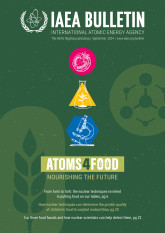
If you would like to learn more about the IAEA’s work, sign up for our weekly updates containing our most important news, multimedia and more.
How nuclear techniques can determine the protein quality of children’s food to combat malnutrition
Victor Owino

Global agrifood systems are changing rapidly, driven by factors such as climate change. These changes can have adverse ramifications in terms of both access to and the availability of nutritious foods. Low concentrations of essential nutrients, such as protein in major food crops, is one way climate change undermines nutrition security, especially among the world’s most vulnerable populations, such as infants and young children.
India continues to bear the brunt of the double burden of malnutrition. According to the 2022 Global Nutrition Report, 35 per cent of all children below 5 years of age are stunted, meaning they are too short for their age, while 17 per cent are wasted, meaning they are too thin for their height.
The World Health Organization and the United Nations Children’s Fund recommend that babies should be exclusively breastfed until they are six months old, without any additional foods or fluids other than prescribed medicines.
Children aged between 6–23 months are the most affected by foods deficient in essential nutrients, as this period coincides with the introduction of complementary foods in addition to breast milk. In about 80 per cent of cases in India, these foods consist of grains (cereal and legumes), while less than 20 per cent are from animal sources such as meat, fish, poultry and eggs. These plant-based foods seldom supply the right balance of nutrients, especially essential amino acids needed for rapid growth and development.
By building capacity to accurately measure the protein quality of food for infants and young children, it is possible to tackle malnutrition with evidence based data and improved dietary recommendations on protein intake. Determining the protein quality of plant-based foods is especially relevant given the environmental consequences related to consumption of animal-source food.
Protein quality is defined as the proportion of protein or amino acids ingested that is absorbed and utilized by the body. There are limited options for measuring protein quality in humans, as the standard method involves the invasive procedure of intestinal intubation to collect a sample of the ingested food as it undergoes digestion in the intestine. The sample is analysed to determine the concentration of free amino acids after a period following a meal. In 2014, an Expert Consultation convened by the Food and Agricultural Organization of the United Nations (FAO) recommended new methods, including stable isotope-based approaches to measure protein quality based on a newly recommended index: the digestible indispensable amino acid score (DIAAS). One of the methods recommended was the dual isotope tracer technique (DSIT), which was developed, tested and optimized in the context of an IAEA-supported coordinated research project in seven countries.
A research team from the St John’s National Academy of Health Sciences in Bangalore, India, deployed the DSIT to measure protein and essential amino acid digestion from commonly used infant foods such as rice, finger millet and mung beans. These were compared to chicken egg, which contains a very easily digestible protein that is often used as a reference protein.
Crops were first ‘watered’ with deuterium oxide, which is similar physically and chemically to ordinary water but is slightly denser. Once harvested, the crops were used to prepare culturally appropriate test meals to which a carbon-13 labelled standard amino acid was added. The test meals containing two isotopes (deuterium and carbon-13) were fed to children aged 6–24 months.
“Protein quality is very relevant for child growth and development,” says Nirupama Shivakumar, lead researcher and author at St John’s National Academy of Health Sciences.
“The dual isotope method is the best approach in children as it is minimally invasive. We found eggs to have the best protein digestibility compared to other protein sources, which is no surprise, and re-emphasises the quality of animal proteins. Considering the slow rate of improvement in children’s nutritional indicators, the incorporation of animal source protein in a child’s daily diet, particularly in food insecure populations, may benefit growth and development.”
Isotope concentration was measured in both blood and breath with an isotope ratio mass spectrometer. The digestibility of each of the essential amino acids was calculated as the ratio of isotopic enrichment in blood/breath to that in the test meal. Results showed that the digestibility of essential amino acids — methionine, phenylalanine, threonine, lysine, leucine, isoleucine and valine — was significantly lower in rice, finger millet and mung bean compared to egg. Further, it was shown that the lower the DIAAS, the higher the risk of stunting.
“These findings are very relevant in shaping guidelines on dietary protein intake in India and beyond,” says Cornelia Loechl, Head of the IAEA’s Nutritional and Health-Related Environmental Studies Section.
The results of the IAEA-supported research have been used in India to inform new complementary food formulations to achieve a good balance of essential amino acids.
Child development schemes have now been integrated into government policies in many states in India, thereby ensuring that milk and eggs are provided to toddlers and school-age children in preschool settings and government-run schools.
Additionally, this data will be included in a future joint FAO–IAEA database on the protein digestibility of human foods to inform future discussions on protein requirements across age and physiological groups. The new database is currently under development.






